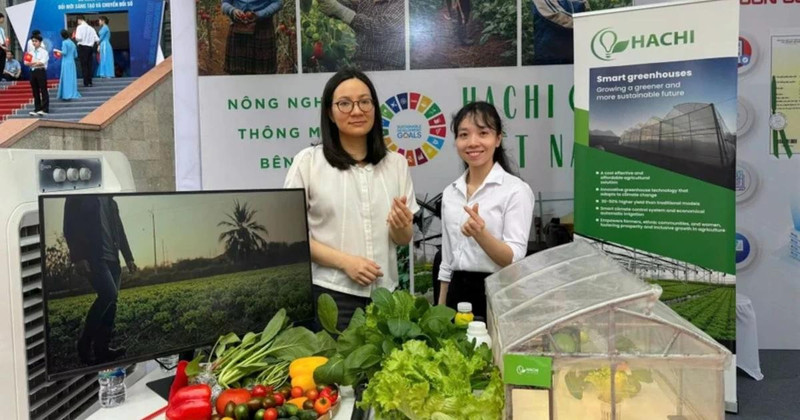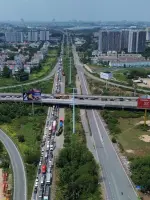
In the context of increasingly stringent global environmental standards, green transition is one of the essential requirements that must be met to help Vietnamese enterprises enter the international market.
Digital technology as a lever for green startups
One of the major challenges for green enterprises is the effective management of human resources and ensuring labour safety, especially at factories and construction sites, which are both high-risk and require high speed and precision.
The HSAFE solution from Le Duong Company is a prime example: a device mounted on a safety helmet allows real-time monitoring of health and labour performance, heart rate, body temperature, positioning, and safety warnings.
Mr Le Dinh Tuyen, the company director, said HSAFE is not only a safety monitoring tool but also a “digital profile,” helping businesses manage human resources transparently and optimise production efficiency.
Not limited to the industrial sector, digital transformation is also opening clear prospects for agriculture, an industry heavily impacted by climate change. Startup Hachi has developed a hydroponic farming model integrating IoT and AI, enabling the measurement of indicators such as humidity, light, temperature, and then automatically adjusting the amount of water and nutrients accordingly.
This model helps save up to 70% of water, increases productivity by 3-5 times compared to traditional methods, and is suitable for urban areas with limited space. “No need for large land areas or abundant labour, this model suits smart agriculture in mountainous and delta regions,” said Ms Nguyen Thi Mai Huong, COO of Hachi High-Tech Joint Stock Company. Through automation applications, Hachi has brought advanced agricultural technologies from Israel, Japan, and Korea into Vietnam.
According to Mr Pham Duc Nghiem, Deputy Director of the Startup and Technology Enterprise Department (Ministry of Science and Technology), in the context of rapid climate change, land degradation, and rising emission reduction pressures, Vietnam is shaping a green, smart, and sustainable agriculture. Though this process requires high costs, the long-term benefits are superior. Conversely, if slow to act, enterprises will not only fall behind but also lose competitive opportunities.
New “agents” of green growth
The green transition is no longer a “game” exclusive to large corporations. From small weaving workshops to rural cooperatives, more and more models are emerging as nuclei of the circular economy. One such model is Gai Thien Phuoc Group Joint Stock Company – a pioneer in researching the exclusive AP1 green hemp variety, developing organic cultivation zones in various provinces, and investing in high-tech factories that meet international standards to produce antibacterial, breathable, and durable green hemp fibres.
In 2018, this startup received USD 1 million from the World Bank via the Ministry of Science and Technology to develop technology for green hemp cultivation and processing, marking a significant step in applying science to sustainable production.
Hemp – planted once and harvested for ten years – is opening a sustainable path for green agriculture. With more than 2,000 hectares of raw material, farmers can harvest up to four crops/year, earning an average income of 100 million VND/ha.
Hemp is not only a raw material for textiles but can be fully utilised: leaves for cakes, roots for medicinal use, stems for mushroom cultivation and soundproof materials. The production chain is restructured under a circular model, from seed varieties, cultivation, processing, to logistics and traceability, meeting strict standards of the EU, the US, and Japan.
In the context where ESG standards have become mandatory, the green hemp value chain, from seed to consumption, not only greens barren land and creates stable livelihoods but also contributes to the sustainable materials revolution in the textile industry.

Green transition can begin with individuals willing to innovate in every field, plot or small workshop, using new technology, thinking, and effective policy connection. In Nghe An, the “Nutritional ecosystem from green agricultural products” model of Mom Beauty Company is a prime example: no chemicals, biodegradable packaging, by-product recycling, and closed-loop operations from seed to consumption.
Automation helps reduce labour from ten to three people while productivity increases. The workforce mainly consists of rural women trained in management and digital warehouse operations. Product value increases 4-6 times thanks to deep processing and green consumption.
The company guarantees high-price output contracts, with production reaching hundreds of tons per year in districts such as Nam Dan and Do Luong. By-products such as seed washing water and rejected seeds are recycled into biological fertilisers, reducing plastic waste and saving resources. With a circular economy spirit, the project won the special prize in the 2024 “Women Startup Innovation and Green Transformation” competition.
“Green buds” shaping the future of sustainable development
From rice fields to factories, from manual production to modern industry, many Vietnamese enterprises are showing that innovation and technology are the keys to unlocking green doors. Green transition does not necessarily begin in the largest places, but where there is new thinking, decisive action, and effective connections between policy and community.
According to the Deputy Minister of Science and Technology, Hoang Minh, Vietnam currently has over 4,000 innovative startups, but only about 5-7% focus on green transition. Though still modest, these are the “green buds” shaping the future of sustainable development. The fourth P4G Summit, recently held in Hanoi, affirmed that in the era of sustainable development, green transition is no longer a choice but has become a mandatory condition for Vietnamese businesses to survive and reach the world.

On the green transition journey, startups, especially small and medium-sized ones, still face many barriers: lack of capital, incentives, and clear ESG standards. Many experts believe that although there have been green credit promotion initiatives, to truly accelerate the transition, a list of green projects and specific standards should be issued soon. This will provide a basis for businesses and banks to access capital transparently and effectively.
In addition, green credit needs lower interest rates and more favourable conditions than traditional loans to encourage businesses to invest in sustainable projects. To ensure effective green transition, it is necessary not only to have clear legal frameworks but also to set specific goals for each sector, aligned with long-term sustainable development policies.
“In addition to enterprises actively improving capacity, integrating digital technology, and developing green products, the State needs to complete policies playing the role of a “midwife” – from green credit, tax incentives, mandatory ESG standards, to human resource training support and innovation encouragement,” emphasised Pham Duc Nghiem, Deputy Director of Startup and Technology Enterprise Department.
Nghiem believes the business community looks forward to a national award for green growth, honouring enterprises not only pioneering in waste management, energy saving, and environmentally friendly product development, but also those inspiring the community toward sustainable development. Another key factor is raising social awareness, from businesses to consumers. As the market increasingly favours green products, consumers will become a driving force for businesses to continue investing in sustainable production.
Resolution No. 68-NQ/TW (dated May 4, 2025) of the Politburo defines the private economy as a key driver, emphasising the role of innovation, technology enterprises, and green startups. Building a green startup ecosystem, especially among small and medium enterprises, is a step to concretise this policy, promoting growth associated with technology, environment, and sustainable development.
With close coordination between the State, businesses, and scientists, the green startup ecosystem will have greater potential to spread from urban to rural areas, from farms to factories. This is also the path for Vietnam to not only realise its net-zero emissions commitment by 2050 but also gradually affirm its position as an innovative nation for a green and sustainable future.
Tra My




